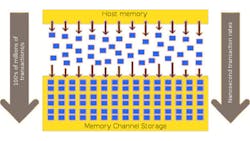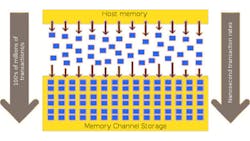Memory Channel Flash Storage Provides Fast RAM Mirroring
Diablo Technologies has delivered its memory channel-based flash storage (see “Large-Scale Flash Moves Next To The Microprocessor”) technology through a number of vendors including IBM and SanDisk. The SanDisk ULLtraDIMM Solid State Drive is a DDR3 DIMM that is built using Diablo Technologies' Memory Channel Storage (MCS) architecture. It essentially puts a DRAM-compatible controller on a DIMM with a bunch of NAND flash. The processor can then access flash storage with much lower latency than PCI Express-based NVMe or SATA/SAS drives that have an additional controller between the PCI Express interface and the flash chips.
Diablo Technologies latest moves to DDR4 was expected. It is called Carbon2 and it provides faster throughput and lower latency. But Diablo has added a new twist as well. Initially the flash was accessed as a conventional block device. Device drivers for all major operating systems were available to provide access to flash plugged into the DIMM sockets. Diablo is also working with some developers and universities to take advantage of direct access that the flash storage. This could provide some interesting speed up but would require application changes whereas the block devices look like any other flash or disk storage.
The new twist is called NanoCommit (Fig. 1) and it takes advantage of the low level MCS interface but with a streamlined API. Essentially NanoCommit acts as a mirror for DRAM. Mirroring can occur at the memory row level with 64 byte transactions. This can reduce latency below 3.3 microseconds. This also boosts the transaction rate compared to the larger block transactions.
NanoCommit is not designed to mirror all DRAM. Instead blocks would be specified for mirroring using an API. This would allow smaller changes like database row updates to occur quickly with little software overhead.
Developers will be able to chose which method is used with MCS DIMMs. It is possible to use both at the same time.
Carbon2 will be available soon but developers can utilize the MDK2 development kit to simulate the DDR4 implementation. It is FPGA-based but it provides the ability to handle early development including device driver creation. This will be followed by a reference design kit with drivers for Linux, Windows and VMware.
MCS provides high capacities compared to NVDRAM (see “Non-Volatile DIMMs and NVMe Spice Up The Flash Memory Summit”) that combines DRAM and flash on the same DIMM. MCS allows server managers to determine the mix of flash and DRAM to put into the limited number of DIMM sockets. Luckily servers are being delivered with ever more DIMM sockets.
NanoCommit allows MCS to compete with the NVRAM solutions while providing higher capacity and lower cost per gigabyte. Diablo Technologies and their partners are targeting the large server farms that need high capacity and high reliability. The technology is also ideal for embedded applications such as high speed data logging.
About the Author
William G. Wong
Senior Content Director - Electronic Design and Microwaves & RF
I am Editor of Electronic Design focusing on embedded, software, and systems. As Senior Content Director, I also manage Microwaves & RF and I work with a great team of editors to provide engineers, programmers, developers and technical managers with interesting and useful articles and videos on a regular basis. Check out our free newsletters to see the latest content.
You can send press releases for new products for possible coverage on the website. I am also interested in receiving contributed articles for publishing on our website. Use our template and send to me along with a signed release form.
Check out my blog, AltEmbedded on Electronic Design, as well as his latest articles on this site that are listed below.
You can visit my social media via these links:
- AltEmbedded on Electronic Design
- Bill Wong on Facebook
- @AltEmbedded on Twitter
- Bill Wong on LinkedIn
I earned a Bachelor of Electrical Engineering at the Georgia Institute of Technology and a Masters in Computer Science from Rutgers University. I still do a bit of programming using everything from C and C++ to Rust and Ada/SPARK. I do a bit of PHP programming for Drupal websites. I have posted a few Drupal modules.
I still get a hand on software and electronic hardware. Some of this can be found on our Kit Close-Up video series. You can also see me on many of our TechXchange Talk videos. I am interested in a range of projects from robotics to artificial intelligence.


